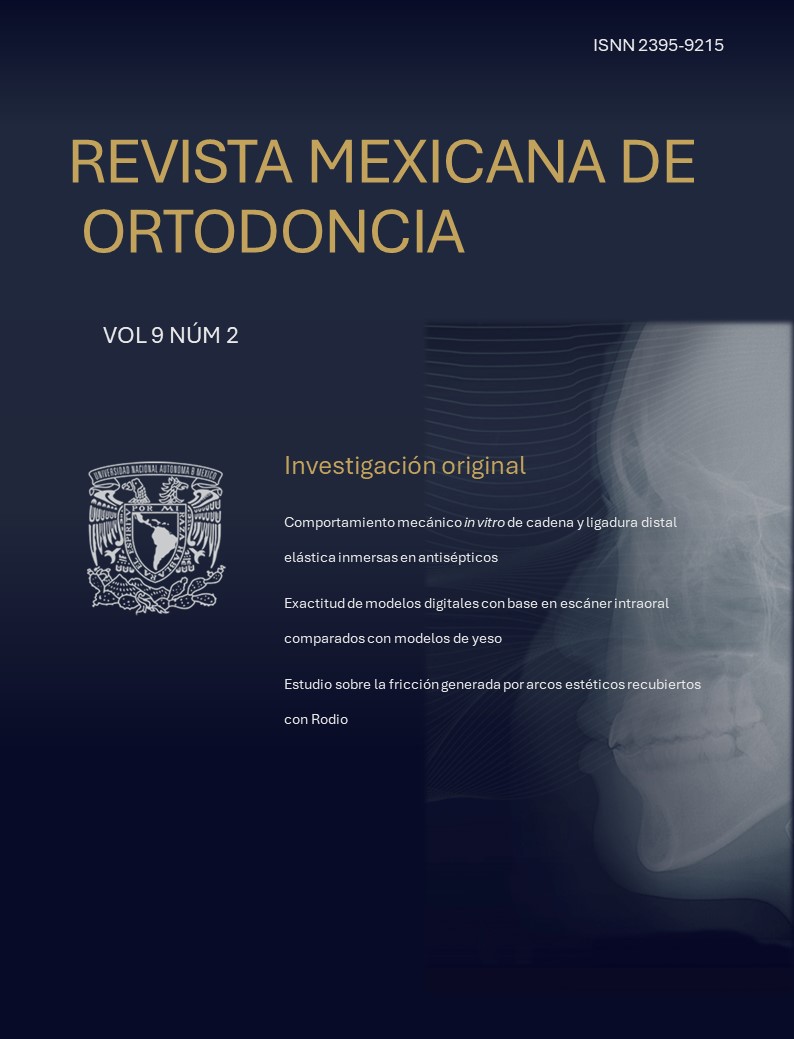Comparing the Accuracy of Intraoral Scanner Digital Models and Plaster Models
Main Article Content
Abstract
Introduction: The use of intraoral scanners in dentistry has been increasing in recent years, the reasons for this are the elimination of impression materials, but mainly the speed and convenience of the records obtained. Objective: To present the comparison of dental arch models obtained from two conventional impression methods (alginate and polyvinylsiloxane) and intraoral scanning to determine if there are discrepancies in size. Materials and methods: An observational, analytical, prospective, cross-sectional study was carried out in which 15 patients (9 males, 6 females) were selected from the Faculty of Dentistry of the Universidad Tecnológica de México. For each patient, study models were taken with three different methods. Method 1: Impression with alginate, Method 2: Impression with polyvinylsiloxane, Method 3: Intraoral scanning. Subsequently, plaster models were obtained from Methods 1 and 2, and 3D models were printed based on Method 3. With a digital vernier, the models were manually measured at five transverse distances and the results were analyzed with anova for independent samples (p>0.05). Results: There are no significant statistical differences between the upper and lower inter canine, upper and lower first premolar, upper and lower second premolar, upper and lower first molar, upper and lower second molar transverse distances in Method 1, Method 2, and Method 3. Conclusions: The intraoral scanning system in conjunction with 3D printing technology is a reliable system to be able to reproduce the transverse discrepancies of the measurements of the dental jaws, however depending on its final use other factors such as the type of 3D printing technology should be taken into consideration for its correct clinical application.
Article Details
Citas en Dimensions Service
References
Papadiochos I, Papadiochou S, Emmanouil I. The historical evolution of dental impression materials. J His Dent. 2017; 65(2): 79-89.
Phillips RW. La ciencia de los materiales dentales de Skinner. 9a ed. México: McGraw-Hill Interamericana; 1993.
Cova Natera JL. “Materiales de impresión”. Biomateriales dentales: para una odontología restauradora exitosa. 3 ed. Medellín, Colombia: AMOLCA; 2019.
Duret F, Blouin JL, Duret B. CAD-CAM in dentistry. J Am Dent Assoc. 1988; 117(6): 715-720. DOI: 10.14219/jada.archive.1988.0096
Budak I, Keses B, Sokovic M. Application of contemporary engineering techniques and technologies in the field of dental prosthetics. Journal of Achievements of Materials and Manufacturing Engineering. 2012; 54(2): 233-241.
Geetha T. A comparison of plaster, digital, and reconstructed study model accuracy. [Masters Thesis]. Chennai, India: Ragas Dental College and Hospital; 2011. Disponible en: http://repository-tnmgrmu.ac.in/3916/2/240502311geethathirunavukkarasu.pdf
Freedman M, Quinn F, O'Sullivan M. Single unit CAD/CAM restorations: a literature review. J Ir Dent Assoc. 2007; 53(1):38-45.
Ahad AR, Kobashi S, Tavares JMRS. Advancements of image processing and vision in healthcare. J Healthc Eng. 2018: 8458024. DOI: 10.1155/2018/8458024
Serrat Barón M. Evaluación in-vitro de la precisión de los escáneres de uso en la Odontología digital para la confección de estructuras para prótesis sobre implantes. [Tesis doctoral]. Barcelona: Universitat Internacional de Catalunya, Departament d’Odontologia; 2017. Disponible en: http://hdl.handle.net/10803/461768
Quaas S, Rudolph H, Luthardt RG. Direct mechanical data acquisition of dental impressions for the manufacturing of CAD/CAM restorations. J Dent. 2007; 35(12): 903- 908. DOI: 10.1016/j.jdent.2007.08.008
Kravitz ND, Groth C, Jones PE, Graham JW, Redmond WR. Intraoral digital scanners. J Clin Orthod. 2014; 48(6): 337-347.
Burzynski JA, Firestone AR, Beck FM, Fields HW, Deguchi T. Comparison of digital intraoral scanners and alginate impressions: Time and patient satisfaction. Am J Orthod Dentofacial Orthop. 2018; 153(4): 534-541. DOI: 10.1016/j.ajodo.2017.08.017
Abduo J, Elseyoufi M. Accuracy of intraoral scanners: A systematic review of influencing factors. Eur J Prosthodont Restor Dent. 2018; 26(3): 101–21. DOI: 10.1922/EJPRD_01752Abduo21
Ahlers MO, Mörig G, Blunck U, Hajtó J, Pröbstere L, Frankenberger R, Guidelines for the preparation of CAD/CAM ceramic inlays and partial crowns. Int J Comput Dent. 2009; 12(4): 309-325.
Teramoto Ohara A, Nicolás Rosa L, Rojas Escartín AK, Rodríguez Pinzón YT. Estudio comparativo de modelos de estudio dentales utilizando diversas impresoras 3D. Revista Digital@ULA.MX. 2020; 1(3): 15-22. http://portaldeinvestigacion.ula.edu.mx/investigacion/images/pdf/2020/Revista-Digital-_ULA-vol.-3.pdf
Santoro M, Galkin S, Teredesai M, Nicolay OF, Cangialosi TJ. Comparison of measurements made on digital and plaster models. Am J Orthod Dentofacial Orthop. 2003; 124(1): 101-105. DOI: 10.1016/s0889-5406(03)00152-5
Camardella LT, Vilella OV, Breuning H. Accuracy of printed dental models made with 2 prototype technologies and different designs of model bases. Am J Orthod Dentofacial Orthop. 2017; 151(6): 1178-1187. DOI: 10.1016/j.ajodo.2017.03.012
Pandis N. Sample calculations for comparison of 2 means. Am J Orthod Dentofac Orthop. 2012; 141(4): 519–521. DOI: 10.1016/j.ajodo.2011.12.010
